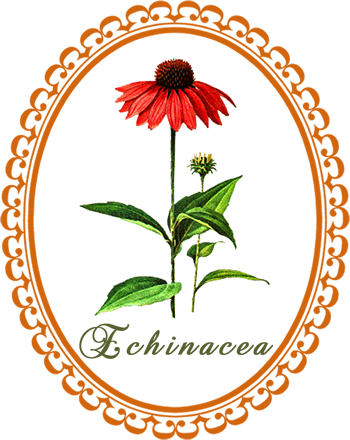
Echinacea: this powerful immune system booster can stop a cold or the flu before it gets a foothold ...
Common Names: Purple Coneflower, Sampson Root
Botanical Names: Echinacea augustifolia
Family: Asteraceae
Plant Type: Hardy perennial
Parts Used: Roots, cone flower
Flowering: July - October
Echinacea, or purple coneflowers are native to eastern and central North America, where they are found growing in moist to dry prairies and open wooded areas.
Nature at Risk: With the commercial popularity of this plant, purple coneflowers have been virtually eliminated from much of their native ranges. Fortunately, these hardy plants can be easily grown in a home flower garden. If this is not a viable option, then try to use only organically cultivated products.
Description: Echinacea is a tall hardy perennial that grows to three feet in height. The oval, lanceolate, bristly leaves are clustered at the base and scattered along a hairy reddish stem. The large daisy-like flowerheads are 1 to 4 inches wide with a bristly conical centre of brown-purple disc flowers surrounded by drooping magenta to pale purple ray flowers.
Cultivation: Echinacea prefers rich, moist, well-drained soil in full sun. It is hardy to zone 3.
Harvesting: Harvest roots in autumn once the plant is two to four years old. Dry in shade.
Native American Herb Wisdom
Echinacea angustifolia was widely used by the North American Plains Indians for its general medicinal qualities. Although Native American tribes didn't use echinacea to prevent the common cold, some of the tribes did use echinacea to treat some of the symptoms that could be caused by the common cold: The Kiowa used it for coughs and sore throats, the Cheyenne for sore throats, the Pawnee for headaches, and many tribes used it as an analgesic, including the Sioux from South Dakota.
Native Americans learned of E. angustifolia by observing elk seeking out the plants and consuming them when sick or wounded, and identified those plants as elk root.
Source: wiki
Echinacea was used by Native Americans as an offering to the spirits to ensure and strengthen spells.
Herbal Healing with Echinacea
Medicinal Actions: Alterative, anti-catarrhal, anti-microbial, tonic
Medicinal Uses: Echinacea is a blood purifier and antibiotic. It's used to stimulate and strengthen the immune system, and is useful against both bacteria and viruses.
Contraindications:
- Theoretically, echinacea is contraindicated in patients with autoimmune disorders, multiple sclerosis, AIDS, TB, and organ transplants because it may stimulate T cells.
- Echinacea inhibits some cytochrome P-450 enzymes and stimulates others; it can therefore potentially interact with drugs metabolized by the same enzymes for example: anabolic steroids, azole antifungals, methotrexate (RHEUMATREX).
- Allergic reactions are possible in patients with pollen allergies.
Adverse effects: Most adverse effects are mild and transitory; they include dizziness, fatigue, headache, and GI symptoms. No other adverse effects are known.
Body Care with Echinacea
- At the first sign of an infection: every three to four hours during the first 24 hours of illness, take up to three size 00 capsules filled with powdered echinacea root or 1 1/2 teaspoons echinacea tincture in a little water.
- To strengthen your healing energy, drink a wine glassful of echinacea decoction.
Decoction: 30g (1 oz) dried echinacea root in 750 ml (3 cups) water.
Tincture: 200g (7 oz) dried echinacea root in 1 litre (4 cups) vodka-water mix.
Source: The Essential Herbs Handbook by Leslie Bremness
If you appreciate the information provided,
please help keep this website running. Blessings!
© 2008-2025 aromaworx.ca. All rights reserved.

